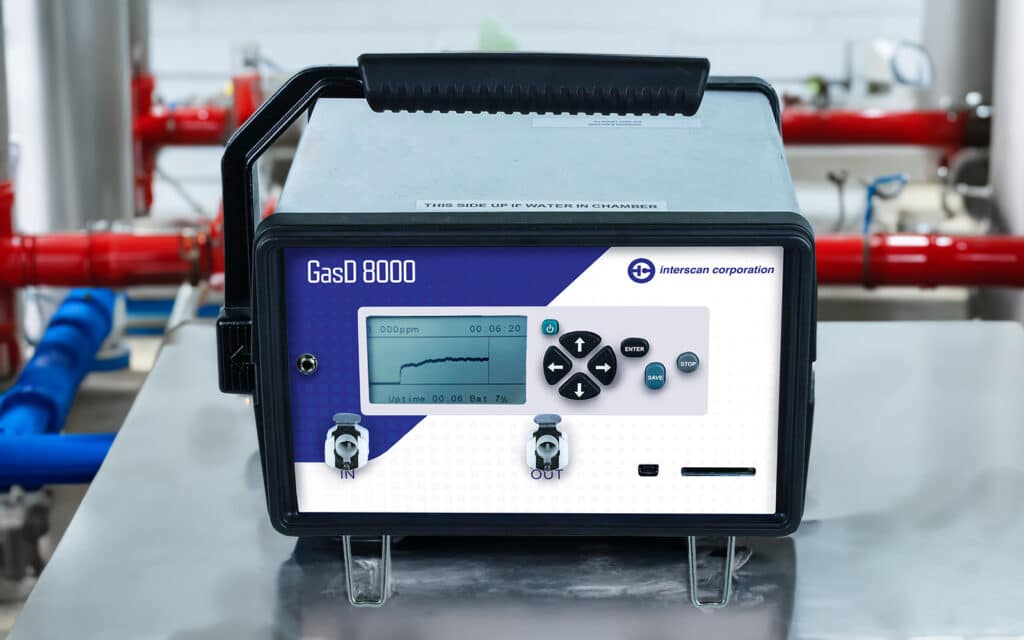- Propylene oxide is a mutagen and a probable human carcinogen.
- The insulation factories that are major users of the compound risk exposing their staff to this toxic and flammable liquid and vapor.
- Detection, strict safety protocols, and use of personal protective gear are necessary to ensure staff safety and health.
The insulation factories use propylene oxide as a raw material to manufacture polyurethane foams. Though accidental spills are few due to the controls in place, exposure to this toxic and flammable liquid still occurs and is a serious workplace hazard. Safety managers, therefore, need to be aware of its dangers and the various means, including detection and safety protocols, to control occupational hazards arising from its use.
Propylene Oxide Use in Insulation Factories
Propylene oxide is a versatile chemical compound with significant industrial applications. The market for the compound is expected to increase with a CAGR of 5.6% from 2021 to 2026 to reach USD 29.5 billion by 2026. However, the workplace hazards it represents impede faster growth in its use.
One of the primary applications of propylene oxide is its use as an intermediate in producing polyether polyols, which are essential components in manufacturing polyurethane plastics. These polyols create various polyurethane products with varying characteristics, such as flexibility, rigidity, and density. Rigid foams for thermal insulation are made from polyols with low relative molecular masses. In comparison, flexible polyurethane foams are found in furniture and automobile seating, bedding, and carpet underlay.
Propylene oxide also produces surfactants, lubricants, glycols, etc.
Risk of Propylene Oxide Exposure in Insulation Factories.
Propylene oxide is stable when stored in recommended conditions. However, it is very volatile, evaporates rapidly, and escapes into the air upon release. As a result of its widespread industrial use, there is potential for occupational exposure to propylene oxide for workers in insulation factories.
The National Occupational Exposure Survey conducted in the early 1980s in the United States indicated that 421,000 U.S. employees were potentially exposed to propylene oxide. Of this number, only 2% were directly exposed to propylene oxide, while the remaining 98% were exposed to propylene oxide materials. These estimates were not based on actual exposure measurements but on company surveys.
Recent data from NIOSH (the National Institute for Occupational Safety and Health) suggests that the situation has improved, and around 200,000 workers in the U.S. are potentially exposed to propylene oxide. Workers in factories with urethane applications, such as those producing insulation, are part of this group.
What Makes Propylene Oxide Hazardous?
It is necessary to know the fundamental properties and characteristics of propylene oxide that make it a concern for workplace safety.
Propylene oxide is not a natural product. It is produced using two primary methods: the chlorohydrin process, which involves the reaction of propylene with chlorine, and the hydroperoxide process, which uses organic hydroperoxide to epoxidize propylene.
Propylene oxide is a chemical compound with the molecular formula C3H6O primarily used in industrial applications. It is a clear, colorless, volatile liquid at room temperature and pressure.
Propylene Oxide Fire Risks
One of the main reasons for concern is that propylene oxide is highly flammable. Both the liquid and vapor forms are flammable and should be handled carefully.
- Aqueous mixtures containing as little as 0.75% propylene oxide can be explosive.
- Vapor levels between 1.6 to 42 percent can explode if ignited. So open heat or flame and temperatures above 50°C close to the compound should be avoided. Propylene oxide vapor can result in flash fire or explosion.
Propylene oxide vapor is heavier than air, which can accumulate in low-lying areas and pose a fire hazard. The vapor can also travel far and constitute downwind explosion hazards. Moreover, fire produces toxic gases and causes storage cylinders to explode.
Due to its flammability, proper safety precautions, such as adequate ventilation and appropriate protective equipment, are essential when handling propylene oxide.
Propylene oxide has a sweet, ether-like odor. The odor threshold for propylene oxide vapor is variable and ranges from 35 to 200 parts per million (ppm). So, while its smell at relatively low concentrations is detectable, it is not a reliable detection method in case of exposure.
Health Exposure Hazards
Propylene oxide is an occupational hazard also because of its health effects.
Acute Exposure Effects
Propylene oxide exposure effects on the skin, eyes, alimentary, nervous, and respiratory systems are felt immediately or after a while.
- Contact irritates skin and eyes, which could lead to eye damage.
- It can cause abdominal pain, vomiting, and diarrhea.
- Exposure leads to dizziness, lightheadedness, headache, lack of coordination, and unconsciousness.
- Propylene oxide irritates the nose, throat, and lungs. It can cause coughing and shortness of breath. Exposure to higher concentrations could result in pulmonary edema.
Chronic Exposure Effects
Propylene oxide is classified as a Group B2 by the U.S. Environment Protection Agency (EPA) because it is a probable human carcinogen.
Other chronic effects include the following:
- A reduction of fertility in men and women.
- Repeated exposure to propylene oxide vapor irritates the lungs, and chronic exposure causes bronchitis, coughing, shortness of breath, and phlegm.
- Propylene oxide causes skin allergies with redness, itching, and rash. Once skin allergy has developed, even low subsequent exposures can trigger symptoms.
Proper safety measures and protective equipment are necessary when working with this chemical.
Permissible Limits
There is no safe level of exposure to a carcinogen, so it is impossible to limit cancer risks from propylene oxide. Different agencies have recommended workplace exposure limits to reduce other health effects and explosion risks.
- Occupational Safety and Health Administration (OSHA) has set the airborne permissible exposure limit (PEL) averaged over an 8-hour workshift at 100 ppm.
- The American Conference of Governmental Industrial Hygienists (ACGIH) threshold limit value (TLV) is 2 ppm as an 8-hr TWA.
- Exposure to 400 ppm is immediately dangerous to life.
Detecting and Monitoring
Detecting and monitoring propylene oxide in insulation factories is essential for worker safety and compliance with environmental regulations. Propylene oxide is a volatile organic compound (VOC) and a potential carcinogen, so continuous monitoring is necessary to detect and control its levels.

Detection
Factories use gas and chemical sensors for propylene oxide detection.
- Gas sensors are commonly used to detect VOCs like propylene oxide. These sensors can be portable or fixed, and they work by measuring changes in electrical conductivity or other properties in the presence of the target gas.
- Chemical Specific Sensors are specifically designed to detect propylene oxide. These sensors offer high selectivity and sensitivity but may be more expensive.
Sensors should be placed strategically where propylene oxide might be emitted. For example, Permanent sensors must be connected to storage bullets. Personnel entering confined spaces and areas of suspected leaks should use portable sensors to ensure they do not encounter propylene oxide.
Safety managers must choose detection methods suitable for the insulation factory’s specific conditions and needs. They should consult experts or industrial hygienists to assess and improve safety measures.
They could consider GasD 8000 Series Portable Gas Analyzers with electrochemical sensors specifically for propylene oxide. Three options have different measurement ranges and sensitivity to suit varying needs.
Whichever method is chosen, it’s essential to regularly calibrate and maintain the detection equipment to ensure accurate and reliable results.
Safety Protocols
Monitoring systems can be integrated with ventilation and safety protocols.
- Safety protocols and PPE: Workers must know the risks of working with propylene oxide. Implementing safety protocols and providing workers with appropriate personal protective equipment (PPE) when working with or around propylene oxide is essential.
- Regulations: Safety managers at insulation factories must be aware of and adhere to local and national laws regarding the handling and emission of propylene oxide. Compliance is crucial to avoid legal and environmental issues.
Keep Properties in Mind
Each compound is different. Propylene oxide’s unique properties and risks must be considered in insulation factories when developing detection programs, training, and equipping personnel with the necessary gear. For more information on safe workplace controls and practices to reduce propylene oxide exposure and its hazards, see this N.J. Health document.
 Vijayalaxmi Kinhal
Vijayalaxmi Kinhal
Science Writer, CID Bio-Science
Ph.D. Ecology and Environmental Science, B.Sc Agriculture
Sources
Centers for Disease Control and Prevention. (2014, June 6). Carcinogenic effects of exposure to propylene oxide (89-111). Centers for Disease Control and Prevention. https://www.cdc.gov/niosh/docs/89-111/default.html
Hazard identification & risk assessment (HIRA). (n.d.). https://environmentclearance.nic.in/writereaddata/online/RiskAssessment/0807202096CKHE1FRiskAssessment.pdf
IARC Working Group on the Evaluation of Carcinogenic Risks to Humans. Some Industrial Chemicals. Lyon (F.R.): International Agency for Research on Cancer; 1994. (IARC Monographs on the Evaluation of Carcinogenic Risks to Humans, No. 60.) Propylene Oxide. Available from: https://www.ncbi.nlm.nih.gov/books/NBK507443/
N.J. Health. (2008). Hazardous Substances Fact Sheet- Propylene oxide. Retrieved from https://nj.gov/health/eoh/rtkweb/documents/fs/1615.pdf
Propylene oxide market size, share 2021 – 2026. Markets and Markets. (n.d.). https://www.marketsandmarkets.com/Market-Reports/propylene-oxide-market-55659975.html


